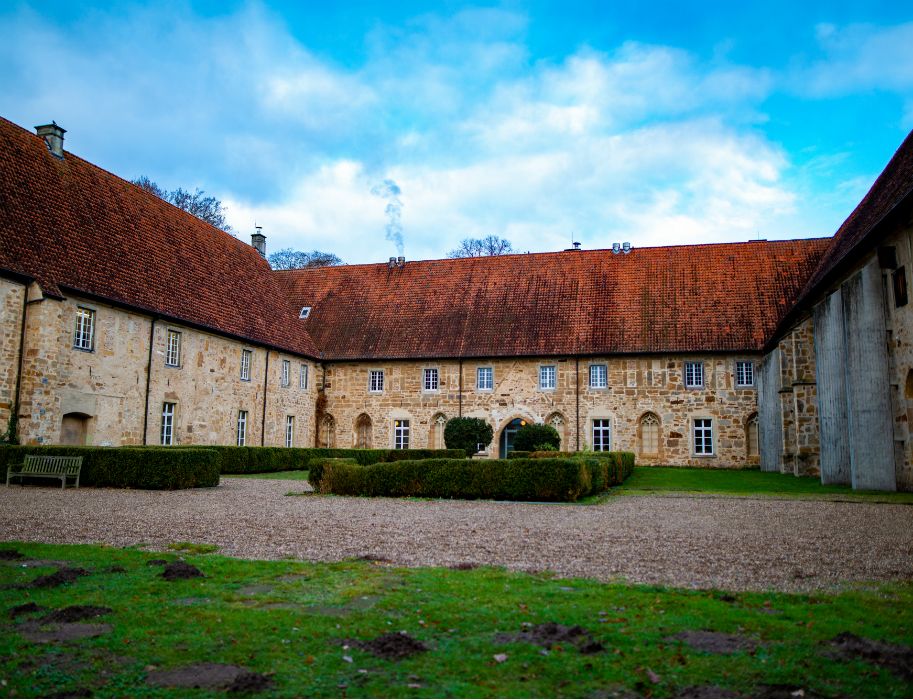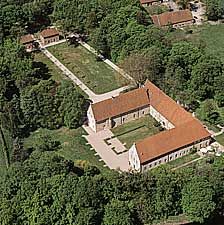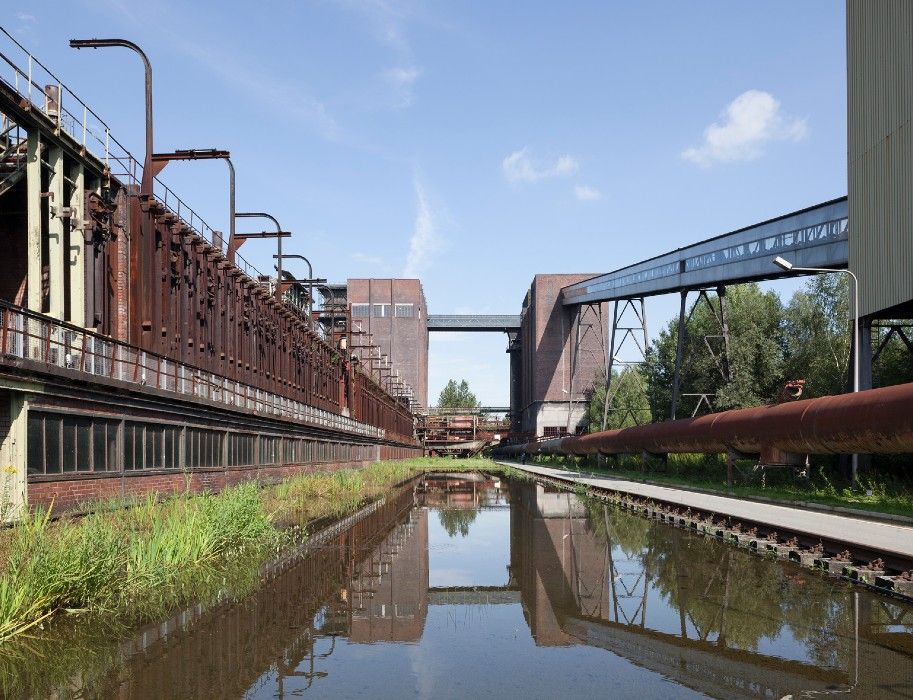Nature and culture in harmony - that is the extraordinary charm of Bentlage Monastery. Impressive exhibitions of contemporary art, a museum on the history of the monastery and on classical modernism as well as a varied cultural programme. The monastery park and wonderful cycle paths along the banks of the Ems invite you to relax. Many good reasons to visit the Bentlage Monastery in Rheine. Tour informationA tour of the outside of the monastery is possible at any time. The Museum Kloster Bentlage is open all year round from Tuesday to Sunday, including public holidays. Different opening hours may apply on some public holidays.The Klostercafé Bentlage is open all year round, Tuesday to Sunday and public holidays.History informationThe oldest reference to Bentlage is found in the siphon register of the Werden an der Ruhr monastery from the year 890, here however still under the name "Binutloge", later Niederbentlage. In the 11th century, more precisely in 1022, Bentlage was mentioned again. Money and land were donated to the village of Buntlagi (Bentlage) for the upkeep of the church of the Billunger noble family. In the following years, a chapel was built and dedicated to St. Gertrude. In 1437, the Order of the Holy Cross, whose members called themselves Brothers of the Cross and, from the 15th century onwards, Knights of the Cross, founded Bentlage Monastery. It was the third monastery of the order in Westphalia. The Bishop of Münster transferred the Gertrude Chapel and the Rector's house to the Order. On 24 April, Pope Eugene the IV signed the foundation charter in Bologna. In the same year, the Brothers of the Cross acquired the Niederbentlage farm. Only after 20 financially difficult years did the financial situation improve so that construction of the monastery could begin. Construction of the buildings began as early as the second half of the 15th century. In addition to the new construction of the large four-wing complex, a hall church and an adjoining monastery school were also built. In the 1500s the convent reached its heyday with about 50 monks. On 21 September 1647 - only 2 years after the completion of the west wing - the monastery was burnt down by Swedish troops during the war. According to reports, all the monks managed to escape from the fire. However, with the exception of the kitchen and some outbuildings, the buildings were badly damaged. In the following 15 years, the monastery was rebuilt. The monastery experienced a second upswing, which was particularly noticeable in the richer furnishings, from the second half of the 17th century. In 1803 the monastery was secularised. The principality of Rheina-Wolbeck, which existed only until 1806, rededicated the monastery as a residential castle. The further use as a manorial residence of the noble family of Looz-Corswarem brought about numerous changes to the buildings and the exterior areas in the first decades of the 19th century. The most conspicuous change is probably the demolition of the monastery church shortly before 1828. Since that time, the monastery has also often been referred to as "Schloss Bentlage". Since 1978 the property has been owned by the city of Rheine, which developed it into a cultural meeting place with the help of a grant from the state of North Rhine-Westphalia from 1990 to 2000. In 1996, the Museum Kloster Bentlage was opened in the east wing. On the ground floor of the museum are historical works of art and documents from the Crusader monastery, including the "Bentlager Reliquary Gardens", which are unique in Germany today. Later, the "Westphalian Gallery" followed on the upper floor with modernist paintings from the holdings of the LWL Museum of Art and Culture in Münster. The cultural meeting place organises an extensive annual cultural programme with exhibitions of contemporary art, theatre productions , concerts and literary events.

This place is certified!
Tourismus NRW e.V., The Westphalian Gallery in the Museum Kloster Bentlage is showing paintings by various artists, including the Westphalian expressionist Wilhelm Morgner Tourismus NRW e.V., The Bentlager Reliquary Gardens are the greatest treasures in the monastery culture collection Tourismus NRW e.V., A stone relief in the Bentlage Monastery Museum Tourismus NRW e.V., The inner courtyard of the Bentlage Crusader monastery near Rheine in Münsterland, which was founded in 1437
Important information about accessibility: certificates
- "Reisen für Alle" (“Travel for All”) is a nationwide, uniform labeling system for barrier-free travel. It offers reliable information on the accessibility of tourist offerings, such as hotels, attractions and means of transport. Providers who allow themselves to be labeled are checked for accessibility by specially trained surveyors. The results are published in detailed test reports so that travelers with disabilities know exactly which offers are suitable for their needs.
Verified information Some information on accessibility are listed below. For detailed information please see the evaluation report.
- There are two designated parking spaces for people with disabilities.
- The entrance/access to the building is step-free.
- Access to the rooms is step-free with the help of elevators or mobile ramps.
- The elevator cabs are at least 110 cm x 140. The elevator doors are at least 90 cm wide.
- The transitions between the exhibitions have thresholds of max. 28 cm.
- There is a mobile folding ramp.
- Doors are at least 66 cm wide.
- Exhibits are predominantly visible, perceptible or recognizable while seated.
- Exhibit information is predominantly legible while seated.
- The counter/cash register is 88 cm high at the lowest point.
- There is another, equivalent communication option available while seated.
Barrier-free WC in the cloister
- The movement areas are: in front of the sink 150 cm x 150 cm; in front of the WC 150 cm x 150 cm; to the left of the WC 123 cm x 55 cm; to the right of the WC 20 cm x 55 cm.
- There are grab rails to the left and right of the WC.
- The left grab rail can be folded up (Yes).
- The washbasin is accessible from underneath at a height of 67 cm and a depth of at least 30 cm.
- The mirror is visible in sitting and standing position.
Public toilet in the outdoor area of the economy
- The movement areas are: in front of the sink 138 cm x 150 cm; in front of the WC 150 cm x 138 cm; to the left of the WC 105 cm x 70 cm; to the right of the WC 104 cm x 70 cm.
- There is a grab bar to the left of the WC.
Detailed information for people with walking difficulties and wheelchair users Some information on accessibility are listed below. For detailed information please see the evaluation report.
- A general parking space is available.
- An outgoing emergency call in the elevator is confirmed acoustically, e.g. by an intercom system.
- There is no inductive hearing system at the counter.
- There are no technical options for conveying information.
- Information for orientation is available in written form.
Detailed information for people with hearing impairments and hearing loss Some information on accessibility are listed below. For detailed information please see the evaluation report.
- Assistance dogs (companion dogs, guide dogs for the blind, etc.) may be brought into all relevant areas/rooms.
- The entrance area is visually contrasted with the surroundings.
- There is visual contrast between the exhibits and the surrounding area.
- Exhibits are generally well lit.
- Information is conveyed in writing.
- An outgoing emergency call in the elevator is confirmed acoustically, e.g., by an intercom system.
- Controls are visually contrasting.
- The signage is designed in easily legible lettering.
Detailed information for people with visual impairments and the blind Some information on accessibility are listed below. For detailed information please see the evaluation report.
- The destination of the trail is within sight or trail signs are at a constantly visible distance or an uninterrupted wayfinding system is in place.
- Exhibit information: Information is conveyed in writing.
- Name or logo of the establishment/facility is clearly visible from the outside.
- The counter is directly visible from the entrance door or the path to it is pictorially marked without interruption.
Detailed information for people with walking difficulties and wheelchair users
Important information at a glance
(01.01-31.12) Exhibitions and museum in Bentlage Monastery
Opening hours valid for the museum and temporary exhibitions
On public holidays the Sunday opening hours apply
Groups by appointment also possible outside opening hours(21.01-31.12) Bentlage Monastery Café
Open todayWednesday 13:00 - 17:00 Thursday 13:00 - 17:00 Friday 13:00 - 17:00 Saturday 13:00 - 17:00 Sunday 13:00 - 17:00
Good to know
More information
Contact
Kulturelle Begegnungsstätte Kloster BentlageBentlager Weg 130
48432 Rheine
Phone: +49 (0)5971 918468
E-Mail: info@kloster-bentlage.de










